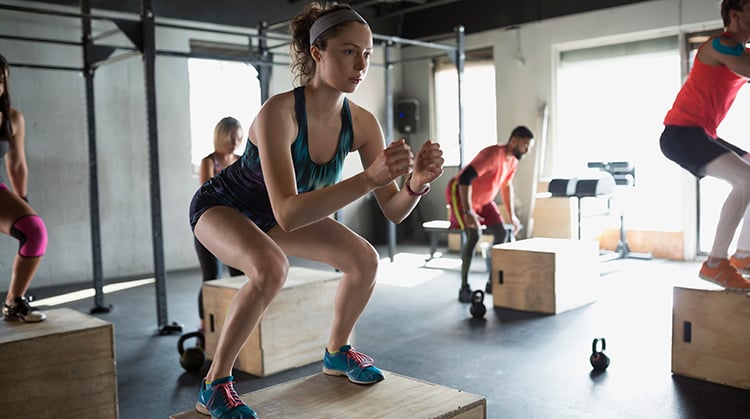Physical Therapy Guide to Female Athlete Triad
Female athlete triad is a condition involving three factors: energy availability, bone mineral density, and the menstrual cycle. An imbalance in any of these areas can lead to eating problems, low bone density, and menstrual cycle changes. Development of the female athlete triad increases the risk for bone stress injuries. As many as 16% of high school, college, and elite female athletes in the United States have all three components of the triad. Around 60% have at least one.
Physical therapists help athletes prevent or resolve female athlete triad. They screen for triad risk, identify the signs, and educate patients on proper health and fitness. They also provide treatment after a related injury. They can initiate treatment and work with or refer you to other health care providers as needed.
Physical therapists are movement experts who use the latest evidence to design treatment plans for each person's needs and goals. They improve quality of life through hands-on care, patient education, and prescribed movement. You can contact a physical therapist directly for an evaluation. To find a physical therapist in your area, visit Find a PT .
What Is Female Athlete Triad?

Female athlete triad involves both the physical and mental aspects of health. It develops in female athletes based on three factors:
- Energy availability (how much energy a woman has to use for activity).
- Bone mineral density (the quality and strength of her bones).
- Menstrual cycle (the regularity of menstrual periods).
Energy availability. The energy you get from your diet, minus the energy you spend on activity determines your energy availability. Typically, poor energy availability leads to lower bone density and abnormal periods. Low energy availability in female athletes has multiple causes, such as a:
- Diagnosed eating disorder.
- Temporary use of abnormal eating patterns to change the body’s appearance.
- Lack of good nutrition during training.
Nutrients from your diet provide a needed source of fuel for bones and muscles. Poor nutrition also can affect how the brain controls the hormones that regulate periods. Optimal energy availability supports bone health and helps the body maintain the right estrogen levels. Estrogen is a hormone that regulates bone building and bone loss. Lack of estrogen can impact bone density and increase the risk of bone stress injuries.
Bone mineral density. Density is one aspect of bone health. Bones that are overstressed by too much exercise and those that do not get the nutrients and hormonal support they need may experience abnormal changes to their structure. When this happens, they begin to lose density, which can lead to osteopenia (lower than normal BMD). Osteopenia can progress to osteoporosis (a loss of bone strength that increases the risk of fractures). A person with low BMD may be at an increased long-term risk of bone mineral loss and fracture as they age.
Menstrual cycle. Dysfunction of the menstrual cycle refers to absent or abnormal menstrual periods. With female athlete triad, menstrual periods may be inconsistent or absent in females from about ages 11 to 51. When a female has low energy availability, her body may limit or eliminate menstrual periods to try to conserve energy.
The high physical demand that female athletes place on their bodies puts them at an increased risk for the triad. Social pressures for performance and body image also can contribute. For example, a female runner may restrict calories too much, believing it will increase her sports success.
Any female athlete can develop the triad, from elite athletes to teens going through puberty. Both physical and psychological aspects can influence the extent, impact, and treatment of this condition.
How Does It Feel?
Symptoms related to the three triad components develop over time, ranging from months to years. The following signs or changes (whether occurring separately or together) may indicate the development of female athlete triad:
- Low energy during school, work, or exercise.
- Irregular or absent periods.
- Stress-related bone injuries (stress reactions or fractures).
- Trouble concentrating.
- A drop in performance that the athlete can't explain.
- Changes in eating habits.
- Altered sleeping patterns.
- An unusually high focus on performance or image.
- High stress levels.
How Is It Diagnosed?
A variety of health care providers typically work together to diagnose female athlete triad. The health care team may include:
- Medical doctors.
- Nutritionists.
- Physical therapists.
- Certified athletic trainers.
- Psychologists.
Those who often spend time with the athlete (such as parents, friends, coaches, and teammates) also may notice signs or symptoms. Sometimes, the athlete does not realize that she has triad symptoms. Therefore, health care providers educate patients, parents, and coaches about the signs and symptoms.
Physical therapists screen for female athlete triad when appropriate. They may ask the athlete questions about her menstrual status and history, past bone injuries, and eating habits. Questions may include:
- Do you have menstrual periods?
- How old were you when your period started?
- How often do you have periods?
- Do your periods change when you are conditioning or during your sport’s season?
- Have you ever had a stress fracture?
- Are you trying to, or has anyone recommended, that you gain or lose weight?
- Are you on a special diet?
- Have you ever been diagnosed with an eating disorder?
Your physical therapist may refer you to other health care providers. They may recommend medical and psychological tests to confirm a diagnosis. These referrals may include ones for:
- A nutritionist, for a dietary assessment.
- Your primary care doctor, who can:
- Monitor menstrual function.
- Order medical tests (such as blood tests).
- Assess development (such as the onset of puberty).
- X-rays or a bone density scan to assess bone health.
Your physical therapist also will perform tests to evaluate your mobility, strength, and movement.
Your doctor may refer you to a physical therapist for an assessment and prescribed exercise.
How Can a Physical Therapist Help?
Physical therapists are trained to screen for female athlete triad. They can identify signs and symptoms and may initiate a team approach to care by referring you to other medical professionals when needed. Physical therapists also educate athletes on preventing the triad. They work with athletes to achieve good health, wellness, and fitness. In addition, physical therapists provide rehabilitation after an injury.
Physical therapists understand the effects that the triad can have on exercise. For example, an athlete with a stress fracture should not jump or run until symptoms resolve. Your physical therapist will design a safe return-to-activity program to promote overall health and wellness. They also can identify any risk for an overuse injury or abnormal stress on your bones or joints.
Physical therapists educate athletes and their families about the triad and help them prevent or resolve the condition. They guide athletes back to safe, optimal performance levels. This care for a female athlete's overall health can improve her performance in sports and school and boost self-esteem. Many athletes report feeling stronger, more confident, and better equipped to achieve their goals when they have strong support and a plan to maintain their health.
Because the triad involves several health components, a team approach to treatment is ideal. Athletes who get care from all relevant providers have the best chance for a healthy return to athletic performance.
Can This Injury or Condition Be Prevented?
Female athlete triad is very preventable. Proper screening by a physical therapist or other health care provider is essential.
The most effective approach to prevention is education. The rate of development of the triad has risen over the last two decades as more women take part in competitive sports. Now, health care providers place more emphasis on educating athletes, parents, and coaches to prevent the triad. It is important to begin educating young female athletes as early as during middle school on topics such as:
- Healthy eating. Good energy availability is essential to prevent development of the triad. Following a healthy diet is a great way to help maintain a vibrant level of energy.
- Smart physical training. This may include changing training plans based on each athlete’s needs.
- The importance of recovery and rest, including good sleep.
- Talking about any challenges, such as fatigue or pain.
Coaches should monitor training and its impact on an athlete's mental and physical health. They also should encourage pain-free participation. Some coaches also may track an athlete’s training and performance. This can help them to notice any abnormal health or behavioral signs. Others in a female athlete’s life should promote an open, honest, and safe space for them to discuss challenges free from pressure or judgment.
What Kind of Physical Therapist Do I Need?
All physical therapists are prepared through education and experience to identify the signs and symptoms of female athlete triad. However, you may want to consider:
- A physical therapist who is experienced in working with people who have female athlete triad. Some physical therapists have a practice that focuses on orthopedics, sports, or women's health.
- A physical therapist who is a board-certified clinical specialist or who completed a residency or fellowship in orthopedic, sports, or women's health physical therapy. This physical therapist has advanced knowledge, experience, and skills that may apply to your condition.
You can search for physical therapists in your area who have these and other credentials by using Find a PT, the online tool built by the American Physical Therapy Association.
General tips when you're looking for a physical therapist (or any other health care provider):
- Get recommendations from family, friends, or other health care providers.
- When you contact a physical therapy clinic for an appointment, ask about the physical therapists' experience in helping people with female athlete triad.
- Be prepared to describe your symptoms in as much detail as possible.
The American Physical Therapy Association believes that consumers should have access to information that could help them make health care decisions and prepare them for a visit with their health care provider.
The following articles provide some of the best scientific evidence related to physical therapy treatment of female athlete triad. The articles report recent research and give an overview of the standards of practice both in the United States and internationally. The titles are linked either to a PubMed* abstract of the article or to free full text so that you can read it or print out a copy to bring with you to your health care provider.
Sutton K, Cheney S, Fierro E, Casey E. The female athlete triad/relative energy deficiency in sports. In: "The Female Athlete." Elsevier; 2022:295–309.
Goolsby M, Boniquit N. Bone health in athletes: the role of exercise, nutrition, and hormones. Sports Health. 2017;9(2):108–117. Article Summary in PubMed.
Stickler L, Hoogenboom BJ, Smith L. The female athlete triad: what every physical therapist should know. Int J Sports Phys Ther. 2015;10(4):563–571. Article Summary in PubMed.
Nazem TG, Ackerman KE. The female athlete triad. Sports Health. 2012;4(4):302–311. Article Summary in PubMed.
Nichols JF, Rauh MJ, Lawson MJ, Ji M, Barkai HS. Prevalence of the female athlete triad syndrome among high school athletes. Arch Pediatr Adolesc Med. 2006;160(2):137–142. Article Summary in PubMed.
Donaldson ML. The female athlete triad: a growing health concern. Orthop Nurs. 2003;22(5):322–324. Article Summary in PubMed.
The Female and Male Athlete Triad Coalition. The Female and Male Athlete Triad Coalition website. Accessed May 11, 2021.
International Society of Sports Nutrition. The International Society of Sports Nutrition website. Accessed March 29, 2018.
* PubMed is a free online resource developed by the National Center for Biotechnology Information. PubMed contains millions of citations to biomedical literature, including citations in the National Library of Medicine's MEDLINE database.
Expert Review:
Apr 5, 2022
Revised:
Jun 7, 2022
Content Type: Guide
Female Athlete Triad
PT, DPT, board-certified clinical specialist in sports physical therapy
Emily Finn
PT, DPT, board-certified clinical specialist in women’s health physical therapy, with a certificate of achievement in pelvic physical therapy
You Might Also Like...
Article
Women's Health Physical TherapyJul 9, 2024
Women's health physical therapy focuses on the unique wellness and rehabilitation needs of women throughout their lifespan, and treatment for the many
Health Tips
Female Athlete Triad: What You Should KnowApr 26, 2022
Female athlete triad is a condition that involves an imbalance among energy availability, quality and strength of bones, and menstrual cycle. Physical
Podcast
Girl Power: Keeping Female Adolescent Athletes Healthy and Prepared for SportsJan 23, 2018
A physical therapist discusses why she strictly treats adolescent female athletes in order keep them empowered and healthy.


